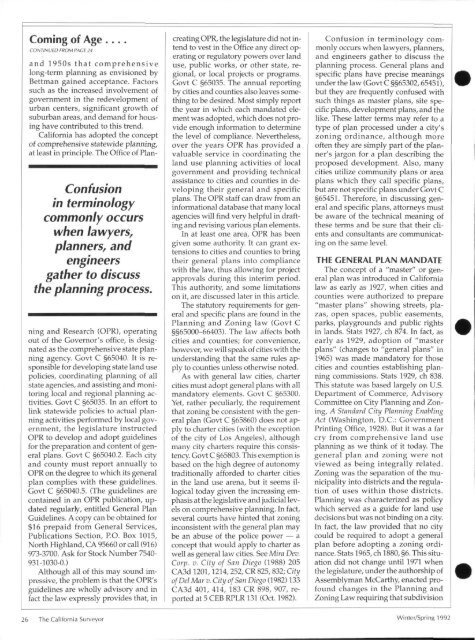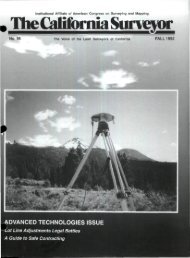You also want an ePaper? Increase the reach of your titles
YUMPU automatically turns print PDFs into web optimized ePapers that Google loves.
Coming of Age ....<br />
CONTINUED FROM PACE 24<br />
and 1950s that comprehensive<br />
long-term planning as envisioned by<br />
Bettman gained acceptance. Factors<br />
such as the increased involvement of<br />
government in the redevelopment of<br />
urban centers, significant growth of<br />
suburban areas, and demand <strong>for</strong> housing<br />
have contributed to this trend.<br />
Cali<strong>for</strong>nia has adopted the concept<br />
of comprehensive statewide planning,<br />
at least in principle. <strong>The</strong> Office of Plan-<br />
Confusion<br />
in terminology<br />
commonly occurs<br />
when lawyers,<br />
planners, and<br />
engineers<br />
gather to discuss<br />
the planning process.<br />
ning and Research (OPR), operating<br />
out of the Governor's office, is designated<br />
as the comprehensive state planning<br />
agency. Govt C §65040. It is responsible<br />
<strong>for</strong> developing state land use<br />
policies, coordinating planning of all<br />
state agencies, and assisting and monitoring<br />
local and regional planning activities.<br />
Govt C §65035. In an ef<strong>for</strong>t to<br />
link statewide policies to actual planning<br />
activities per<strong>for</strong>med by local government,<br />
the legislature instructed<br />
OPR to develop and adopt guidelines<br />
<strong>for</strong> the preparation and content of general<br />
plans. Govt C §65040.2. Each city<br />
and county must report annually to<br />
OPR on the degree to which its general<br />
plan complies with these guidelines.<br />
Govt C §65040.5. (<strong>The</strong> guidelines are<br />
contained in an OPR publication, updated<br />
regularly, entitled General Plan<br />
Guidelines. A copy can be obtained <strong>for</strong><br />
$16 prepaid from General Services,<br />
Publications Section, P.O. Box 1015,<br />
North Highland, CA 95660 or call (916)<br />
973-3700. Ask <strong>for</strong> Stock Number 7540-<br />
931-1030-0.)<br />
Although all of this may sound impressive,<br />
the problem is that the OPR's<br />
guidelines are wholly advisory and in<br />
fact the law expressly provides that, in<br />
creating OPR, the legislature did not intend<br />
to vest in the Office any direct operating<br />
or regulatory powers over land<br />
use, public works, or other state, regional,<br />
or local projects or programs.<br />
Govt C §65035. <strong>The</strong> annual reporting<br />
by cities and counties also leaves something<br />
to be desired. Most simply report<br />
the year in which each mandated element<br />
was adopted, which does not provide<br />
enough in<strong>for</strong>mation to determine<br />
the level of compliance. Nevertheless,<br />
over the years OPR has provided a<br />
valuable service in coordinating the<br />
land use planning activities of local<br />
government and providing technical<br />
assistance to cities and counties in developing<br />
their general and specific<br />
plans. <strong>The</strong> OPR staff can draw from an<br />
in<strong>for</strong>mational database that many local<br />
agencies will find very helpful in drafting<br />
and revising various plan elements.<br />
In at least one area, OPR has been<br />
given some authority. It can grant extensions<br />
to cities and counties to bring<br />
their general plans into compliance<br />
with the law, thus allowing <strong>for</strong> project<br />
approvals during this interim period.<br />
This authority, and some limitations<br />
on it, are discussed later in this article.<br />
<strong>The</strong> statutory requirements <strong>for</strong> general<br />
and specific plans are found in the<br />
Planning and Zoning law (Govt C<br />
§§65000-66403). <strong>The</strong> law affects both<br />
cities and counties; <strong>for</strong> convenience,<br />
however, we will speak of cities with the<br />
understanding that the same rules apply<br />
to counties unless otherwise noted.<br />
As with general law cities, charter<br />
cities must adopt general plans with all<br />
mandatory elements. Govt C §65300.<br />
Yet, rather peculiarly, the requirement<br />
that zoning be consistent with the general<br />
plan (Govt C §65860) does not apply<br />
to charter cities (with the exception<br />
of the city of Los Angeles), although<br />
many city charters require this consistency.<br />
Govt C §65803. This exemption is<br />
based on the high degree of autonomy<br />
traditionally af<strong>for</strong>ded to charter cities<br />
in the land use arena, but it seems illogical<br />
today given the increasing emphasis<br />
at the legislative and judicial levels<br />
on comprehensive planning. In fact,<br />
several courts have hinted that zoning<br />
inconsistent with the general plan may<br />
be an abuse of the police power — a<br />
concept that would apply to charter as<br />
well as general law cities. See Mira Dev.<br />
Corp. v. City of San Diego (1988) 205<br />
CA3d 1201,1214,252, CR 825,832; City<br />
of Del Mar v. City of San Diego (1982) 133<br />
CA3d 401, 414, 183 CR 898, 907, reported<br />
at 5 CEB RPLR 131 (Oct. 1982).<br />
Confusion in terminology commonly<br />
occurs when lawyers, planners,<br />
and engineers gather to discuss the<br />
planning process. General plans and<br />
specific plans have precise meanings<br />
under the law (Govt C §§65302,65451),<br />
but they are frequently confused with<br />
such things as master plans, site specific<br />
plans, development plans, and the<br />
like. <strong>The</strong>se latter terms may refer to a<br />
type of plan processed under a city's<br />
zoning ordinance, although more<br />
often they are simply part of the planner's<br />
jargon <strong>for</strong> a plan describing the<br />
proposed development. Also, many<br />
cities utilize community plans or area<br />
plans which they call specific plans,<br />
but are not specific plans under Govt C<br />
§65451. <strong>The</strong>re<strong>for</strong>e, in discussing general<br />
and specific plans, attorneys must<br />
be aware of the technical meaning of<br />
these terms and be sure that their clients<br />
and consultants are communicating<br />
on the same level.<br />
THE GENERAL PLAN MANDATE<br />
<strong>The</strong> concept of a "master" or general<br />
plan was introduced in Cali<strong>for</strong>nia<br />
law as early as 1927, when cities and<br />
counties were authorized to prepare<br />
"master plans" showing streets, plazas,<br />
open spaces, public easements,<br />
parks, playgrounds and public rights<br />
in lands. Stats 1927, ch 874. In fact, as<br />
early as 1929, adoption of "master<br />
plans" (changes to "general plans" in<br />
1965) was made mandatory <strong>for</strong> those<br />
cities and counties establishing planning<br />
commissions. Stats 1929, ch 838.<br />
This statute was based largely on U.S.<br />
Department of Commerce, Advisory<br />
Committee on City Planning and Zoning,<br />
A Standard City Planning Enabling<br />
Act (Washington, D.C.: Government<br />
Printing Office, 1928). But it was a far<br />
cry from comprehensive land use<br />
planning as we think of it today. <strong>The</strong><br />
general plan and zoning were not<br />
viewed as being integrally related.<br />
Zoning was the separation of the municipality<br />
into districts and the regulation<br />
of uses within those districts.<br />
Planning was characterized as policy<br />
which served as a guide <strong>for</strong> land use<br />
decisions but was not binding on a city.<br />
In fact, the law provided that no city<br />
could be required to adopt a general<br />
plan be<strong>for</strong>e adopting a zoning ordinance.<br />
Stats 1965, ch 1880, §6. This situation<br />
did not change until 1971 when<br />
the legislature, under the authorship of<br />
Assemblyman McCarthy, enacted profound<br />
changes in the Planning and<br />
Zoning Law requiring that subdivision<br />
26 <strong>The</strong> Cali<strong>for</strong>nia <strong>Surveyor</strong> Winter/Spring 1992
















